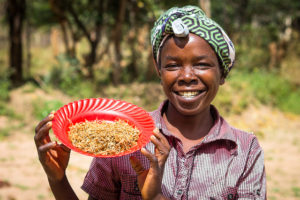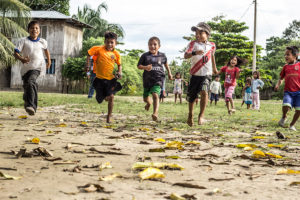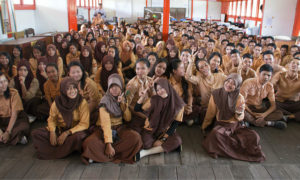
Globally, there are an estimated 1.8 billion young people between 10 to 24 years old. Of these, approximately 90 percent live in the developing world, and mostly in rural areas. Yet often, rural young people are poorly understood in research compared to more ‘visible’ groups, such as urban youth, particularly in Western countries.
This is of special concern to research partnerships such as CGIAR, because young people play critical roles in rural households and environmental transformations, but their interests are often inadequately addressed in programs and policies. However, as a significant social group now and in the future, their aspirations, dreams, opportunities and the particular challenges they face in rural areas deserve to be studied and understood in their own right.
Click here to listen to the webinar recording or download the presentation.
That is one of the many reasons the CGIAR Research Program on Forests, Trees and Agroforestry (FTA) recently presented a webinar on rural youth and livelihood change. The webinar, hosted by the CGIAR Collaborative Platform for Gender Research, invited four researchers and activists to share their thoughts on the challenges and prospects facing rural young women and men across the Global South.
FTA and the CGIAR gender platform hosted the hour-long webinar with key thinkers and practitioners working in youth and development studies in Latin America, Asia and Africa, to address key issues affecting today’s young people, as well as the role of institutions such as CGIAR in supporting the livelihoods of rural youth.

Rural young people’s challenges and opportunities
Jim Sumberg, a Research Fellow in the Rural Futures research cluster at the Institute of Development Studies (IDS), began by problematizing the idea of “the challenges and opportunities for rural young people.” He stressed the need to recognize the diversity within ‘youth’ based on gender, geography, and other factors of social differentiation, and the necessity of considering the specific social and political contexts where they live.
He highlighted the differences between the challenges that rural people face in general, because of, for example, systemic failures or structural issues; challenges that specifically affect rural young people primarily because they are young, have fewer resources, less life experience, and less developed networks, among other factors; and the challenges that affect young people because they are discriminated against or ‘invisible’ to other social groups and decision-makers.
For example, webinar panelist Daniela Rivas, the Peruvian country representative of Young Professionals for Agricultural Development (YPARD), explained that in Peru, young people make up 27 percent of the total population, and 22 percent of the population is specifically composed of rural youth. However, government policy focuses on urban youth. This demonstrates how many indigenous and rural young people face challenges in simply having their voices heard, and therefore remain invisible to rural development initiatives.
Though many rural young men and women face challenges, they also have new opportunities. Jessica Clendenning, a PhD Candidate in Human Geography with the National University of Singapore, explained that as urban centers across the Global South continue to expand, the shape and nature of rural areas also change. New opportunities in rural and urban areas pertaining to forests and agricultural production, marketing and value chains are some such opportunities.
Critical, then, is that young people have access to education and training to gain the skills needed to capitalize on those opportunities, and to enable young people to pursue the types of work that interest them besides primary production.
Read more: Webinar: Rural youth and livelihood change

Role of CGIAR
What roles can CGIAR and FTA play in researching and working with rural youth? Fraser Sugden, a Senior Lecturer in Human Geography at the University of Birmingham, and outgoing coordinator of the Gender, Youth and Inclusion theme in the CGIAR Research Program on Water, Land, and Ecosystems (WLE), suggested that the CGIAR research community could play an important role in engaging with youth on the ground.
This does not necessarily mean encouraging young people to be farmers, but providing them with opportunities in agrobased enterprises and agricultural support services and investments, such as through extension services, research and investment in young agroentrepreneurs.
More broadly, Clendenning explained that CGIAR can use its research and action to address the large knowledge gaps surrounding youth issues in tree and agroforestry environments. For example, little is known about the effects that rural economic diversification, via remittances and migration, has on labor and changing land use dynamics, or about whether, why or when young migrants actually do return to live and work in their natal village areas.
The interests rural young women and men have in the forestry or agroforestry sectors, and the types of related schooling that is offered to them, also require attention. These questions demonstrate that longer term studies are needed to understand rural young men and women, and the ways they are embedded within their families, communities and broader social contexts.
The main takeaway message was the need for CGIAR and partners to see young women and men as a diverse social group that faces different challenges and opportunities. Research methods must recognize their particular experiences, and the intersecting factors of social difference, such as gender, class and ethnicity, all of which influence and shape their choices.
This means integrating young people into program design and development, and researching with young women and men, instead of simply about them.
By Manon Koningstein, FTA Gender Integration Team; Marlène Elias, FTA Gender Research Coordinator; and Jessica Clendenning, PhD candidate.
This work forms part of the CGIAR Research Program on Forests, Trees and Agroforestry, which is supported by CGIAR Fund Donors.











